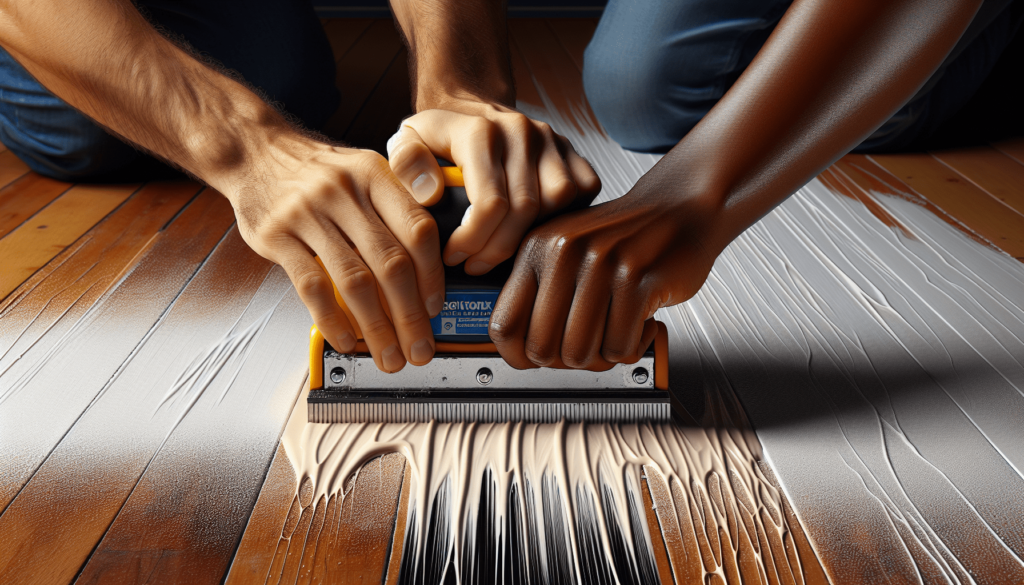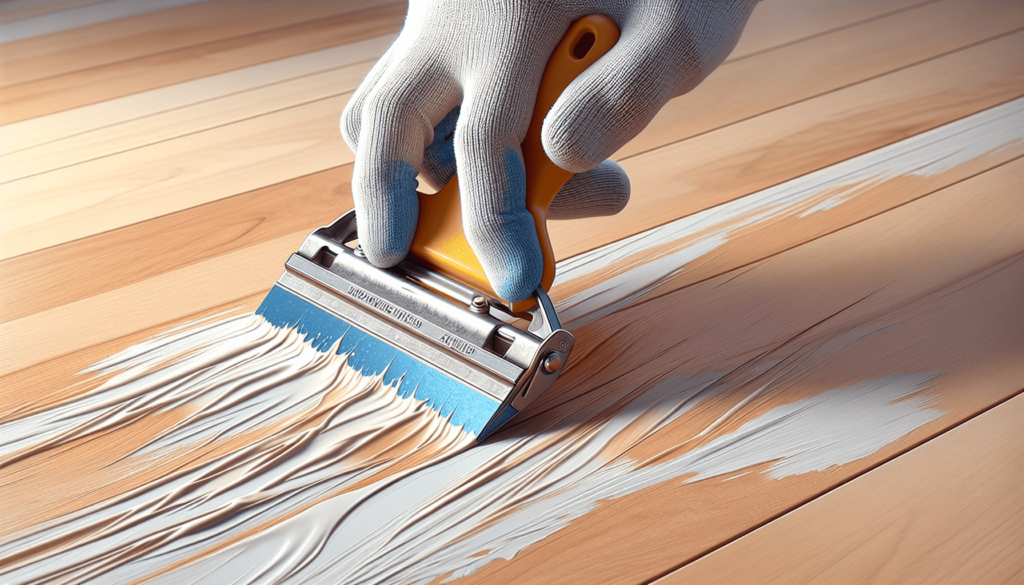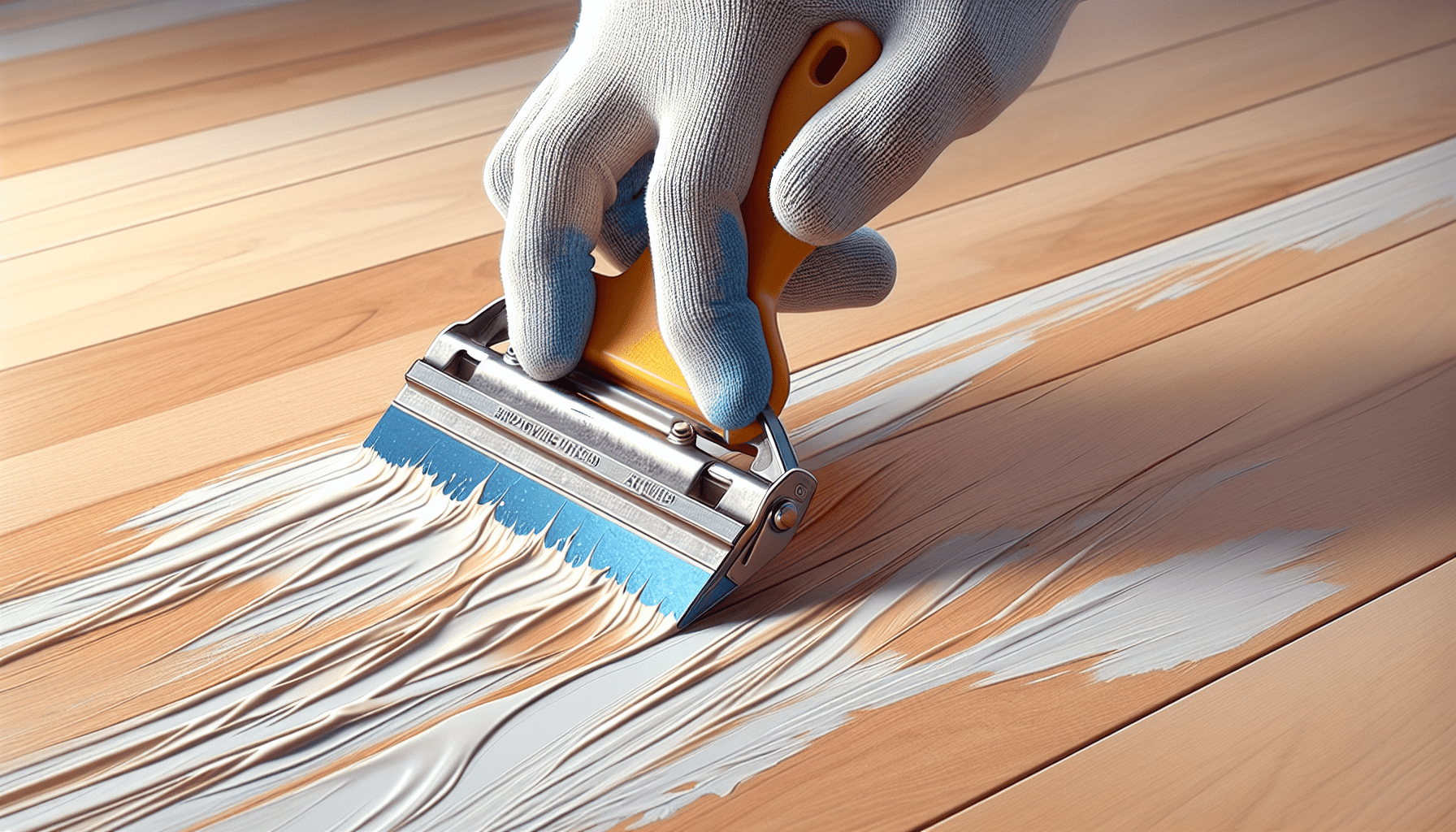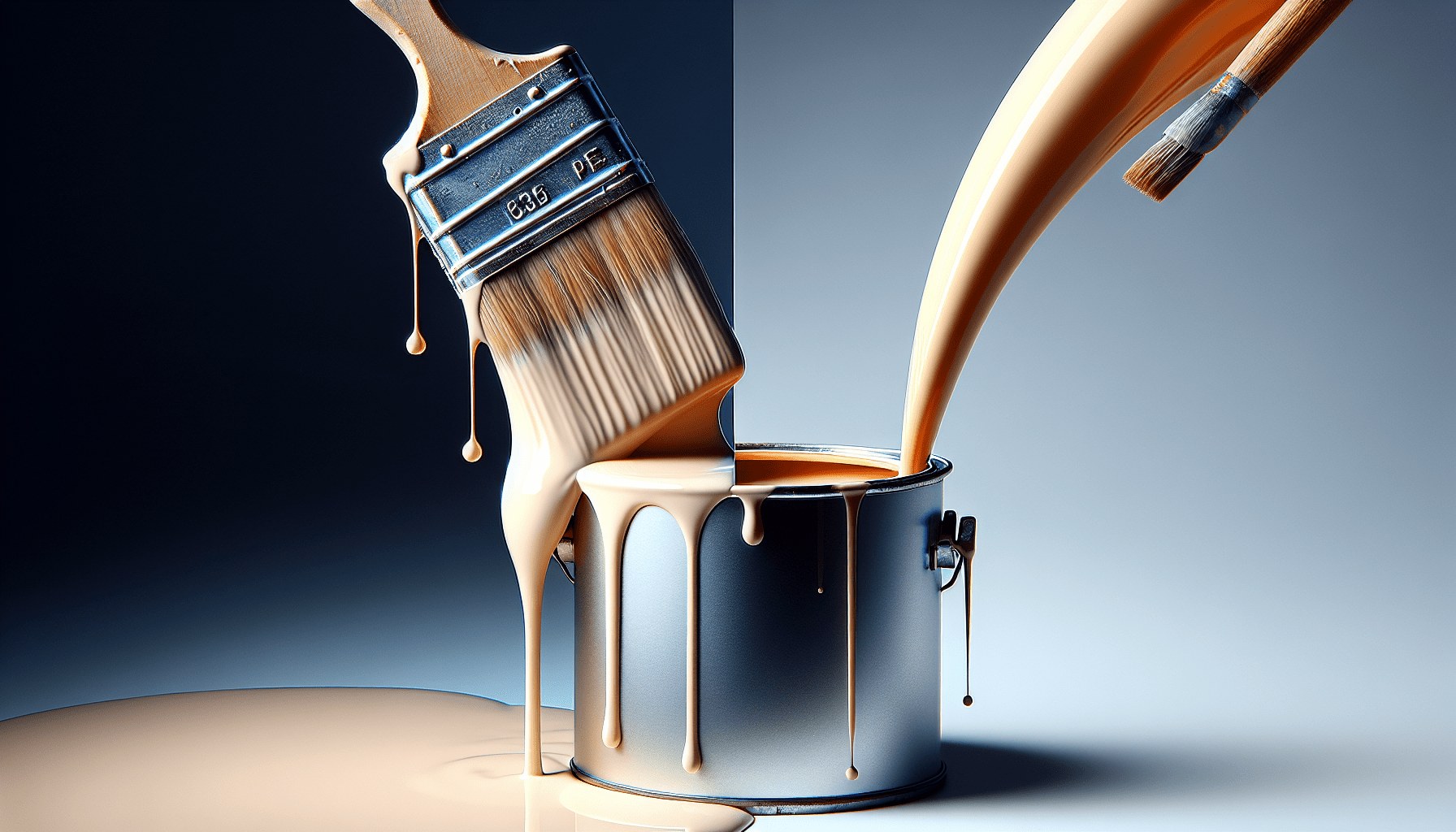Are you struggling with the unsightly dilemma of latex paint stains on your pristine hardwood floors? This article will provide you with the expert guidance and proven techniques you need to effectively remove latex paint without causing any damage to your beloved hardwood surfaces. By following our step-by-step instructions, you’ll soon be able to restore the natural beauty of your hardwood floors and ensure they remain spotless for years to come. Say goodbye to those stubborn paint stains and hello to flawlessly clean hardwood floors with our comprehensive guide.

Materials Needed
To effectively remove latex paint from hardwood floors, you will need the following materials:
Protective gear
It is essential to prioritize your safety while working with cleaning chemicals and tools. You should wear protective gear such as gloves and safety goggles to avoid any potential hazards.
Rubbing alcohol
Rubbing alcohol is an effective solvent that can dissolve latex paint. It is readily available at most pharmacies or grocery stores. Make sure to use isopropyl rubbing alcohol with a high concentration (70% or higher) for optimal results.
Clean cloth
Having a clean cloth is crucial for blotting and dabbing away the paint. Make sure the cloth is lint-free to avoid leaving any residue behind.
Plastic scraper or putty knife
A plastic scraper or putty knife is essential for gently removing wet or dried latex paint from the hardwood surface. Plastic tools are less likely to cause scratches or damage.
Fine-grit sandpaper
If the latex paint is stubborn and cannot be removed with a scraper alone, fine-grit sandpaper can be used to gently sand away the paint residue. Be cautious not to damage the wood surface while sanding.
Wood cleaner or soap
To further clean the area after removing the paint, a suitable wood cleaner or soap can be used. Look for products specifically designed for hardwood floors to avoid any potential damage.
Soft bristle brush
A soft bristle brush is ideal for cleaning and scrubbing the area without causing scratches or marks on the hardwood surface. Make sure to choose a brush suitable for delicate surfaces.
Clean water
Clean water is required for rinsing the area after removing the paint. It helps to remove any cleaning residues and ensures a clean finish.
Microfiber cloth or towel
A microfiber cloth or towel is perfect for drying the hardwood floor without leaving any streaks or lint behind. It provides a smooth and polished finish to the cleaned area.
Preparation
Before starting the paint removal process, it is essential to prepare yourself and the working environment.
Put on protective gear
Ensure you protect yourself by wearing suitable protective gear, including gloves and safety goggles. This will minimize any potential harm or skin irritation from the cleaning chemicals.
Test the rubbing alcohol on a small, inconspicuous area
Before applying rubbing alcohol to the entire paint stain, it is crucial to test it on a small, inconspicuous area of the hardwood floor. This will help you determine if the alcohol will cause any damage or discoloration to the wood.
Open windows or use a fan for proper ventilation
Since rubbing alcohol emits strong fumes, it is necessary to open windows or use a fan to maintain proper ventilation while working. Adequate ventilation will help dissipate the fumes and prevent any discomfort or respiratory issues.
Remove any loose or peeling paint
Before starting the removal process, remove any loose or peeling paint from the hardwood floor. This will make the subsequent steps more effective and prevent any further damage to the wood surface.
Removing Wet Latex Paint
If the latex paint is still wet, follow these steps to remove it from your hardwood floor:
Blot the fresh paint stain with a clean cloth
Start by blotting the fresh paint stain gently with a clean cloth. This will help absorb any excess paint and prevent it from further spreading or seeping into the wood.
Gently scrape off the wet paint using a plastic scraper or putty knife
Using a plastic scraper or putty knife, gently scrape off the wet paint from the hardwood floor. Be careful not to apply too much pressure or aggressively scratch the wood surface.
Apply rubbing alcohol to a clean cloth and dab the paint stain
Moisten a clean cloth with rubbing alcohol and gently dab the paint stain. Rubbing alcohol acts as a solvent and helps to dissolve and remove the paint from the hardwood surface.
Repeat the process until the paint is fully removed
Continue applying rubbing alcohol and dabbing the paint stain until the wet latex paint is fully removed. It may take several attempts, depending on the amount and thickness of the paint.
Clean the area with wood cleaner or soap and soft bristle brush
After removing the paint, clean the area with a suitable wood cleaner or soap. Apply the cleaner to a soft bristle brush and gently scrub the area to remove any remaining residue or stains.
Rinse with clean water and dry with a microfiber cloth or towel
Thoroughly rinse the cleaned area with clean water to remove any traces of the wood cleaner or soap. Once rinsed, dry the hardwood floor with a microfiber cloth or towel to ensure a clean and dry surface.
Removing Dried Latex Paint
If the latex paint has dried, follow these steps to remove it from your hardwood floor:
Scrape off the dried paint gently with a plastic scraper or putty knife
Using a plastic scraper or putty knife, gently scrape off the dried latex paint from the hardwood floor. Be cautious not to gouge or damage the wood surface while scraping.
Dampen a clean cloth with rubbing alcohol and dab the paint stain
Moisten a clean cloth with rubbing alcohol and dab the dried paint stain. Allow the alcohol to soak into the paint for a few minutes. This will help soften the paint and make it easier to remove.
Allow the alcohol to sit on the paint for a few minutes
Let the rubbing alcohol sit on the dried paint for a few minutes. This allows the alcohol to penetrate the paint and break down its adhesive properties.
Scrub the area with a soft bristle brush
Using a soft bristle brush, gently scrub the area where the dried paint stain is located. The rubbing alcohol will help loosen the paint, making it easier to remove during the scrubbing process.
Rinse with clean water and dry with a microfiber cloth or towel
Thoroughly rinse the area with clean water to remove any residual rubbing alcohol or loosened paint particles. Dry the hardwood floor with a microfiber cloth or towel to ensure it is clean and dry.

Removing Stubborn Latex Paint
If the latex paint is stubborn and not easily removed with the previous methods, follow these steps:
Sand the paint gently with fine-grit sandpaper
Using fine-grit sandpaper, gently sand the stubborn paint stain. Sanding helps to remove the paint and smooth out any remaining residue. Be cautious not to sand aggressively or damage the wood surface.
Be cautious not to damage the wood surface
While sanding the paint, it is crucial to be cautious and gentle, ensuring you do not damage the underlying wood surface. A light touch and attention to detail will help avoid any unnecessary scratches or marks.
Wipe away the paint dust with a clean cloth
After sanding, wipe away the paint dust with a clean cloth. This will remove any loose particles and ensure a clean surface for further cleaning.
Apply rubbing alcohol to a cloth and dab the stubborn paint stain
Moisten a clean cloth with rubbing alcohol and dab the stubborn paint stain. The alcohol will soften the paint and make it easier to remove during the subsequent scrubbing process.
Gently scrub the area with a soft bristle brush
Using a soft bristle brush, gently scrub the area with the stubborn paint stain. The rubbing alcohol will further break down the paint, allowing for its successful removal.
Rinse with clean water and dry with a microfiber cloth or towel
Rinse the area with clean water to remove any residual paint particles or rubbing alcohol. Dry the hardwood floor thoroughly with a microfiber cloth or towel to ensure a clean and dry surface.
Dealing with Remaining Residue
If there is still residual paint or residue on the hardwood floor, follow these steps to remove it:
Apply rubbing alcohol directly to the stubborn residue
Apply rubbing alcohol directly to the remaining paint residue. The alcohol will act as a solvent, loosening the residue and making it easier to remove.
Allow the alcohol to sit on the residue for a few minutes
Allow the rubbing alcohol to sit on the stubborn residue for a few minutes. This will give it time to penetrate and break down the residue, making it easier to remove during the scrubbing process.
Scrub the area with a soft bristle brush
Using a soft bristle brush, scrub the area with the remaining residue. The rubbing alcohol should help to loosen the residue, allowing for its successful removal.
Wipe away any remaining residue with a clean cloth
After scrubbing, wipe away any remaining residue with a clean cloth. Make sure to remove all traces of the residue to achieve a clean and polished hardwood floor.
Clean the area with wood cleaner or soap and soft bristle brush
Clean the area with a suitable wood cleaner or soap. Apply the cleaner to a soft bristle brush and gently scrub the area to remove any last traces of the residue or cleaning chemicals.
Rinse with clean water and dry with a microfiber cloth or towel
Rinse the area with clean water to remove any residual cleaning chemicals or residue. Once rinsed, dry the hardwood floor with a microfiber cloth or towel to ensure a clean and dry surface.
Final Touches and Maintenance
After successfully removing the latex paint from your hardwood floor, follow these final steps to ensure a polished and well-maintained appearance:
Inspect the floor for any lingering paint stains or residue
Thoroughly inspect the hardwood floor for any remaining paint stains or residue. Take your time to ensure that the surface is clean and free from any blemishes.
Repeat the appropriate removal method for any remaining spots
If you notice any remaining paint stains or residue, repeat the appropriate removal method specific to the type of stain. By targeting these areas directly, you can eliminate any remaining imperfections successfully.
Ensure the area is clean and dry
Before finishing the process, ensure that the entire area is thoroughly cleaned and completely dry. This will prevent any moisture or residual cleaning products from causing damage or stains on the hardwood floor.
Use a wood cleaner or polish to restore the shine
To restore the shine of your hardwood floor, you can use a suitable wood cleaner or polish. Follow the instructions on the product label and apply it to the entire floor or specific areas as needed.
Regularly clean and maintain the hardwood floors to prevent future paint stains
To prevent future paint stains, it is essential to regularly clean and maintain your hardwood floors. By implementing a regular cleaning routine and promptly addressing any spills or accidents, you can keep your floors looking their best.
Alternative Methods
In addition to the methods outlined above, there are a couple of alternative approaches you can consider for removing latex paint from hardwood floors:
Using a heat gun and scraper
If the paint is particularly stubborn and adhered firmly to the hardwood floor, you can use a heat gun to soften it. Heat the paint carefully using the heat gun, and then gently scrape it off with a plastic scraper or putty knife. Ensure that you maintain a safe distance from the wood surface to prevent any heat damage.
Using a paint stripper
Another alternative method is using a paint stripper specifically designed for latex paint removal. Follow the instructions provided with the paint stripper and ensure proper ventilation while using this chemical-based product. Be cautious and wear protective gear to avoid any contact with skin or eyes.
Preventing Paint Stains on Hardwood Floors
While it’s essential to know how to remove latex paint from hardwood floors, taking preventive measures can save you the hassle in the first place. Here are some preventative steps to follow:
Use drop cloths or plastic sheets to protect the floor
When painting a room, use drop cloths or plastic sheets to cover the floor completely. This will create a barrier between the paint and the hardwood surface, preventing accidental spills or drips.
Cover the floor with cardboard or rosin paper before painting
For added protection, you can place cardboard or rosin paper on top of the drop cloths or plastic sheets. This provides an additional layer of protection against any potential paint splatter.
Be cautious and use painter’s tape to secure protective coverings
To ensure that the protective coverings stay in place, use painter’s tape to secure the edges. This will prevent any accidental movement or displacement during the painting process.
Clean up spills and drips immediately
If a spill or drip occurs while painting, make sure to clean it up immediately. Use a clean cloth or paper towel to blot or wipe away the paint before it dries and adheres to the hardwood floor.
Avoid painting directly on the hardwood floor
Whenever possible, avoid painting directly on the hardwood floor. If touch-ups or minor painting is necessary, use a small brush or applicator to avoid excessive paint spills or drips.
Conclusion
Removing latex paint from hardwood floors can be achieved by following the appropriate methods and using the necessary materials. By taking preventive measures and promptly addressing any paint stains, you can maintain the pristine appearance of your hardwood floors. Remember to prioritize safety, wear protective gear, and follow the instructions provided for each removal method. With careful attention and proper maintenance, your hardwood floors will remain beautiful and paint-free.



